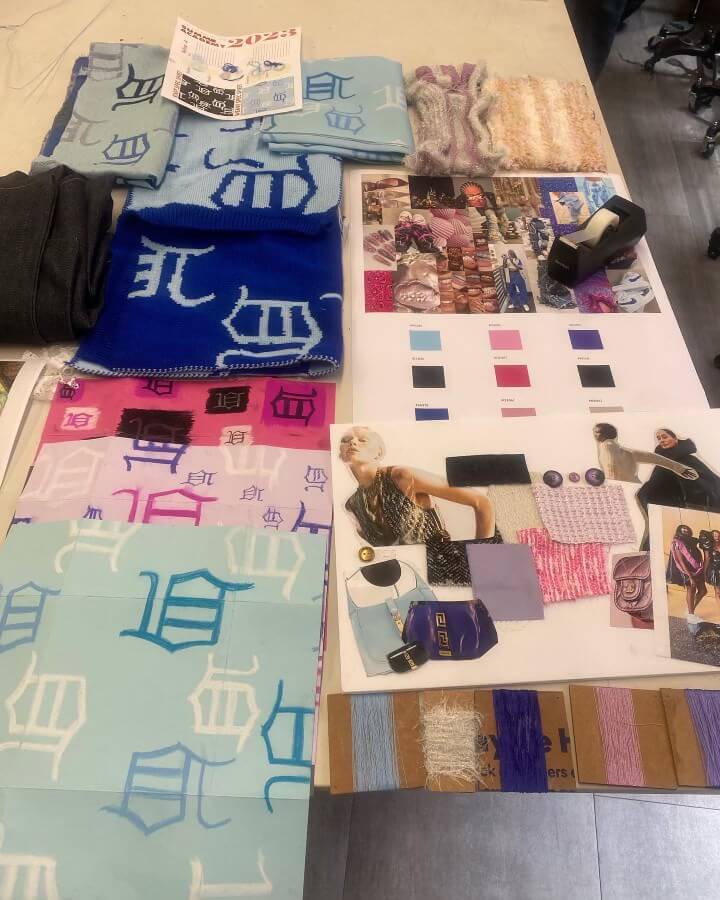Jordan Shanahan ’26 | Abby Whitman ’26
From personal projects to intensive art camps, EA’s students do not let summer hinder their pursuits. Although EA offers a unique environment with a host of creative opportunities, students are given the chance of artistic freedom on their own during summer break.
Many students return to the new school year with new additions to their portfolios. From poetry to fashion design to photography, each artist has a unique method of creating their art. Elle DuPont ‘25 states, “Usually for most [of] my pieces I am listening to music…I try to base some poems off of… one lyric or line I think is really interesting, or a [metaphor from] a book I’m reading.” On the other hand, Tavis Sanders ‘26 tries to step back and take a more defined approach, that “depends on what I’m shooting, but usually, when I’m shooting I’ll try to capture a lot of emotion in my shot.”
Velina Fezeu ’24 composed many of her summer projects at prestigious art schools: “I attended art camps at Thomas Jefferson University and Moore College of Art and Design,” she explains, “Jefferson was about textile, fashion, and fashion merchandising and then Moore was solely about sewing creative garments.” Feuzeu compares her creative process during the school year versus during the summer. “During the school year my art teachers give me a prompt and then I can take that foundation and make my own art,” describes Fezeu. “In the summer it’s really just me and what I want to do,” she adds, “[Summer] is completely self-guided versus your teacher giving you a prompt and then continuing from that foundation.”

Photo Courtesy of @feysfinearts
DuPont remarks, “I definitely do a lot more during the summer because I just have more creative energy.” She is quick to add that “during the school year I really don’t have time to listen to that stuff, so I don’t really do as much poetry.” Sanders corroborates, “[during summer] I was able to go to different events and kind of be thrown into the thick of it and learn how to shoot off of that.” Summer also opened up new opportunities for Sanders, he explains that he was “doing a lot of studio work and technical [aspects] before the shoot.”
Students aren’t the only ones participating in art over the summer as many teachers embarked on their own endeavors. Mr. Sigel, Head of the Arts Department, describes that in the summer he does “a lot of plein air painting,” and that “during nice weather [he] takes [his] field easel and goes out and paints from life.” In a similar fashion Mr. Erwin, Chair of the Music Department, states, “I practice piano daily and I sing daily…over the summer I practiced about an hour and a half every single day, so seven days a week, and I wrote some music.” For Sigel, summer is also a time to plan ahead, explaining that “[he] thinks about what [his] next body of work is going to look like…It’s a lot of landscapes and different things and also kind of [an] imaginary, illustrative children’s book that [he’s] been playing with.”
EA Students are also looking ahead to the upcoming year. DuPont plans to submit her poetry for the Scholastic Awards after strategic refining. “All my poems are unfinished until the moment I submit them,” she discloses. “[The Scholastic Art Awards] deadline is in November or December,” states DuPont. “Usually I’ll write a majority of my pieces during the summer when I get inspiration, not trying to think about submitting.” She adds that to finish her process she will “edit them…at the start of the school year… and make sure [she’s] happy with them before [she] submits them.”
Sanders has an upcoming exhibit planned for this year, explaining, “I am supposed to be having a photography showcase…downstairs this semester.” He adds that he plans to “[submit] art photos to Dora Khayatt as well.” Feuzeu has many upcoming plans for her art, both in and out of school. Fezeu aims to “apply for the Scholastic Art and Writing Awards and dish into the young arts competition.” She also hopes to further her fashion design. “I definitely plan to drop a [fashion] collection in the winter,” reveals Fezeu. She adds, “I am also looking forward to the wearable art contest in April, and now I’m designing the EA/AIS/Haverford t-shirt design.”
Episcopal Artists are encouraged to continue their practices during the summer for numerous reasons. Erwin says,“the arts–performing arts in my case–is a muscle system. [Going without outside of school practice] would be like saying ‘Okay I’m going to play a sport and then take off the entire summer. I’m an expert pianist. If I don’t practice a little bit every day I notice a difference even in a week,” Erwin comments, “it’s really important for singers to constantly exercise that muscle [and] you have to have that muscle memory if you play an instrument.”
Sigel has similar opinions, stating, “being an artist is not just doing art in class—it is a self-discipline. You should take classes if you want to learn something, but then it’s really about individual practice and making sure you’re doing it on your own. We always, ALWAYS, encourage kids to do classes or to continue their practice or being artists outside of the classroom setting.”